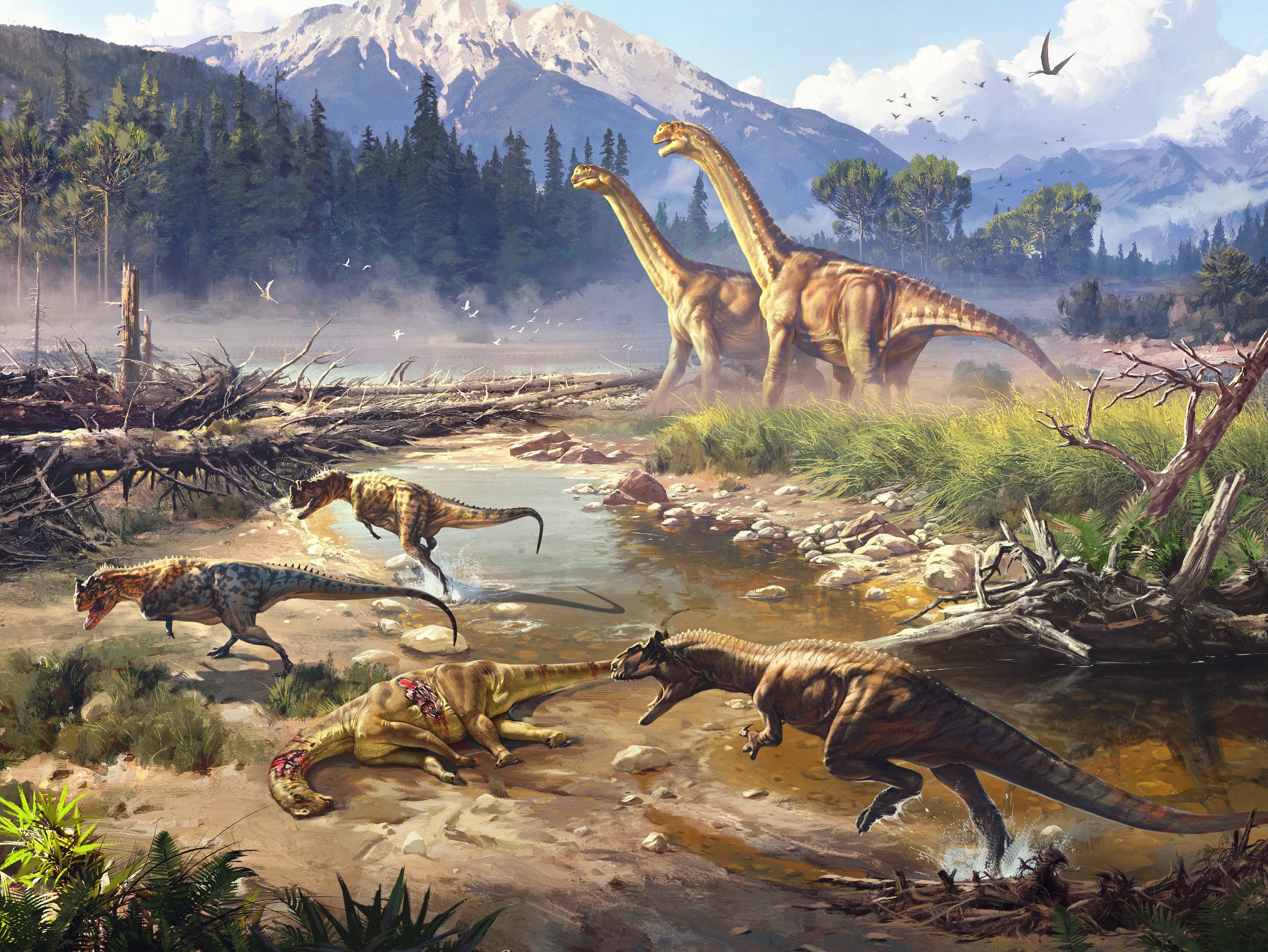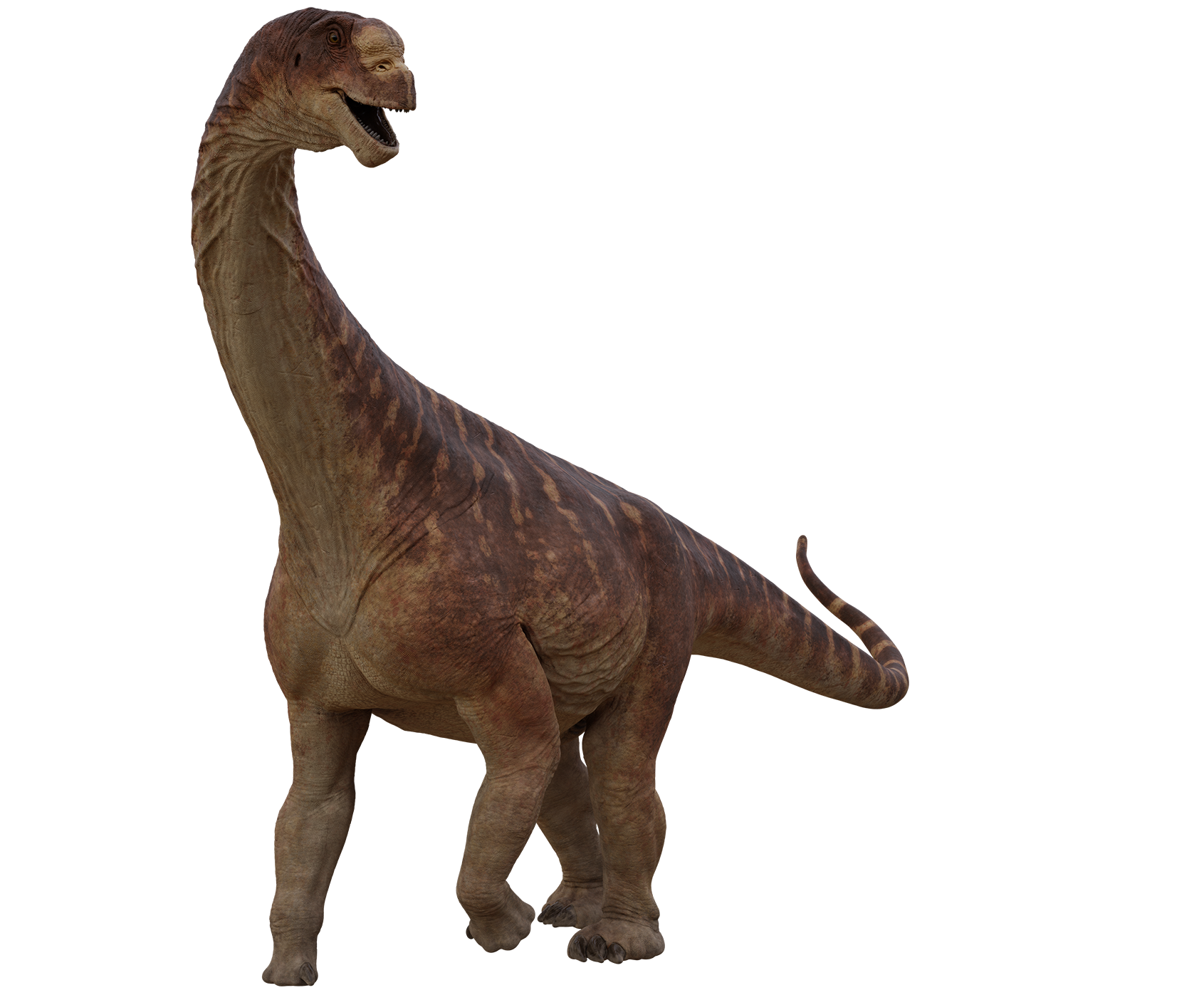The Masters of the Morrison
While Camarasaurus may not have been the largest, longest, or most fearsome dinosaur in Late Jurassic North America, it appears to have been among the most common, being known from over 500 specimens - more than any other dinosaur from the Morrison Formation!
Overview: The Late Jurassic Morrison Formation of western North America was home to many different kinds of sauropods, but by far the most common was Camarasaurus. It was discovered in 1877 and named by the famous E.D. Cope, and since then, some 500 additional specimens have been discovered. It was medium sized for a sauropod and lacked the extreme neck and vertical orientation of Brachiosaurus as well as the extreme horizontal length of diplodocids, and there was probably niche partitioning between all these different sauropods. And whatever Camarasaurus was doing, it worked. While neither the largest nor the fiercest Morrison dinosaur, in terms of numbers, Camarasaurus can be considered the true masters of the Morrison, at least among large herbivores.
Discovery: The first remains of Camarasaurus were discovered at Garden Park, Colorado, by Oramel William Lucas in 1877. The bones were sent to paleontologist Edward Drinker Cope, the famous “Bone Wars” archrival of Othniel Charles Marsh, who named the specimen Camarasaurus supremus, meaning “supreme chambered lizard”. “Chambered lizard” was given because of the large openings in its vertebrae, which were pneumatic cavities that would have housed avian-style air sacs. Three additional species of Camarasaurus would go on to be discovered: C. lentus, and C. grandis by Marsh, and C. lewisi much later by James A. “Jim” Jenson. In total, over 500 specimens of Camarasaurus have been discovered, including around 50 partial skeletons, numerous skulls, five complete necks, and at least one virtually complete juvenile (CM 11338) which is also the most complete sauropod ever discovered. Of these four species, C. supremus, and C. lewisi were comparatively rare, and C. lentus was the most common and is the best-known to paleontologists. The original specimen (holotype) of C. lentus (YPM 1910) was discovered at Como Bluff, Wyoming and named by Marsh in 1889, given the rather unkind name “Morosaurus lentus”, meaning “Tough Stupid Lizard”. Later it was found to belong to Camarasaurus, and so became Camarasaurus lentus, the “tough cambered lizard”. Most specimens of Camarasaurus probably belong to C. lentus, including the aforementioned complete juvenile CM 11338.
Evolution: Camarasaurus was a sauropod dinosaur, with a proportionally long neck, massive rotund body, and pillar-like legs. It was a member of the family Camarasauridae, which in turn was part of the major subdivision of sauropods called Macronaria, or “big noses”, named for the hyper-enlarged nostrils, a clade which also includes brachiosaurids and titanosaurs. Camarasaurus appeared about 155 million years ago and lasted until about 145 million years ago. C. lentus specifically is definitively known from about 151-149 million years ago and may have evolved from the slightly earlier C. grandis and may have in turn been the ancestor of C. supremus.
Description: Camarasaurus had only a moderately long neck by sauropod standards, certainly not short by any means, but not as proportionally elongated as Brachiosaurus or the diplodocids. Its neck would have likely been angled upwards, though probably not to the same degree as Brachiosaurus. At the end of its neck sat a blunt-snouted almost box-like skull with large nostrils and spoon-shaped teeth. C. lentus was a medium-sized sauropod, smaller than the much larger C. supremus. C. lentus could attain lengths of about 15 meters (49 ft) and weighed about 15 metric tons (16.5 short tons), about as much as two and a half elephants. For comparison, C. supremus may have reached 23 meters (75 ft) and 42.3 metric tons (46.6 short tons) possibly rivalling Brachiosaurus in weight.

Behavior and Ecology: Camarasaurus lentus shared its habitat with numerous other herbivores, including several sauropods. These included Apatosaurus, Diplodocus, Barosaurus, Haplocanthosaurus, Supersaurus, and Brachiosaurus. Smaller ornithischian herbivores included Camptosaurus, Dryosaurus, Nanosaurus, and Stegosaurus. All these herbivores, especially the sauropods probably had some form of niche partitioning between them in the form of either habitat preference, preferred plant type, and/or feeding height, in order to avoid competing with each other. The Morrison is thought to have been a semi-arid, seasonally wet floodplain featuring mostly flat fern savanna and gallery forests of ginkgo, tree ferns, cycads, and conifers growing around permanent lakes and rivers. Isolated conifers also probably dotted the fern-savanna. The teeth of Camarasaurus are robust and spoon-shaped, probably for clipping foliage from trees similar to Brachiosaurus, though it wouldn’t have had as high of a browsing height as Brachiosaurus, thus avoiding competition with its larger cousin. Like other sauropods, Camarasaurus did not chew its food. Instead, it probably swallowed stones called gastroliths to grind its food during digestion in the stomach. Being among the most common large herbivores and being smaller targets than some of the other sauropods, Camarasaurus was probably a common prey item for large theropods like Torvosaurus, Allosaurus, and maybe Ceratosaurus. Allosaurus bite marks on Camarasaurus bones confirms that this theropod was indeed at least scavenging them, if not actively hunting them. Juvenile Camarasaurus would have been especially vulnerable to predators, as Camarasaurus have little in terms of defensive features except their large adult size. Lucky for Camarasaurus, like most dinosaurs, it had a warm-blooded metabolism which fueled a very fast growth rate. So they would have only been small for a comparatively short duration of their lives.
Extinction: Camarasaurus lentus seems to have disappeared around 149 million years ago, shortly after the arrival of C. supremus. Climate change and the apparent loss of Brachiosaurus may have pushed C. supremus to become as large as it did, and it probably replaced C. lentus, and may have even evolved from it. All species of Camarasaurus were extinct by the end of the Jurassic around 145 million years ago, though other camarasaurids remained into the Early Cretaceous. Camarasaurus is now the best-known sauropod known to science, with hundreds of specimens and an abundance of museum displays, including the National Museum of Natural History (Smithsonian), in Washington DC, the BYU Museum of Paleontology in Provo, UT, the Wyoming Dinosaur Center in Thermopolis, WY, the Carnegie Museum in Pittsburgh, PA, and the Yale Peabody Museum in New Haven, CT, which houses the C. lentus holotype. Despite being so well-known scientifically, Camarasaurus’s presence in popular culture is somewhat less than other Morrison sauropods, though it does appear in the PBS children’s educational cartoon Dinosaur Train, the 2008 History Channel documentary Jurassic Fight Club, and in the 2001 Discovery Channel documentary When Dinosaurs Roamed America.
Camarasaurus FAQ
Camarasaurus size / How big was Camarasaurus?
See height, weight, and length.
Camarasaurus height / How tall was Camarasaurus?
Camarasaurus lentus was around 7 meters (23 ft) tall!
Camarasaurus weight / How much did Camarasaurus weigh?
Camarasaurus weighed about 15 tonnes (16.5 US tons), more than the combined weight of two African bull elephants!
How long was Camarasaurus?
Camarasaurus lentus was between 15 meters (49 ft) long.
What did Camarasaurus eat?
Camarasaurus ate plants, and probably browsed on trees.
What is Camarasaurus’s closest living relative?
Like all dinosaurs, the closest relatives of Camarasarus are the only surviving lineage of dinosaurs today, the birds. Crocodilians, while not dinosaurs themselves, are also more distant cousins of dinosaurs.
Camarasaurus family members / Camarasaurus family / What kind of dinosaur was Camarasaurus?
Camarasaurus was a sauropod (“long-necked dinosaur”) in the family Camarasauridae. Camarasaurs were in turn part of the larger sauropod clade Macronaria, which makes them distant cousins to Brachiosaurus and to the titanosaurs.
Where did Camarasaurus live? / Where was Camarasaurus found?
Camarasaurus lived in western North America and has been found in Wyoming, Colorado, Utah, and possibly South Dakota.
When did Camarasaurus live?
Camarasaurus lived about 155-145 million years ago in the Late Jurassic Period. Camarasaurus lentus lived in the middle of that time frame, around 150 million years ago.
What does Camarasaurus mean? / Camarasaurus name meaning
Camarasaurus means “chambered lizard”, referring to the hollow spaces (pleurocoels) in its vertebrae.

